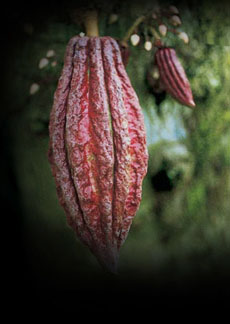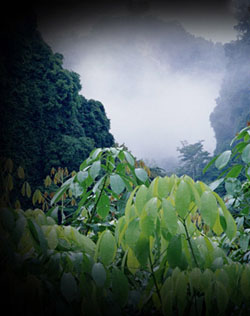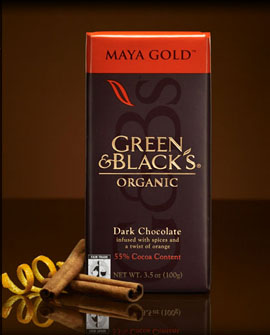

The cabosse, or pod, is the fruit of the cacao tree. Inside is pulpy white fruit, but more important, the cacao seeds or “beans” that become chocolate. Photography courtesy of Green & Black’s.
|
PETER ROT is THE NIBBLE’s chocolate specialist.
|
July 2009
|
 |
Green & Black’s Organic Chocolate Bars
Page 2: History of Green & Black’s
This is Page 2 of a four-page article. Click on the black links below to visit other pages.
History of Green & Black’s
Green & Black’s traces its beginnings to 1991 when Craig Sams—founder of U.K. organic food company, Whole Earth—received a sample of 70% chocolate made from organic cacao beans. Craig’s wife, Josephine Fairley—columnist for The London Times—tasted the chocolate as well, and the response was unanimous: the couple were blown away. Having never tasted chocolate with such intensity and depth of flavor, the two were determined to produce the first organic chocolate available on a mass market scale. That first bar was likewise a 70% cacao; little did Craig and Jo realize that it would plant the seeds for what would become one of the world’s premier organic chocolate brands, Green & Black’s.
Before the brand name was to become a leading trademark for organic chocolate, however, Craig and Jo first needed to conjure it up. After thinking long and hard, they decided on something that they felt would best represent the foundation of the brand. Green symbolizes organic and black represents the dark, near black color of chocolate. An organic star was born (or at least, named).
 Green & Black’s sources its cacao from all over the world, but mainly from the Dominican Republic and Belize; and favors the Trinitario variety. Trinitario is an ideal choice because it contains the robust, deep chocolaty flavor of Forastero and also the complex flavor properties that make Criollo such a prized variety. It’s also a hardy crop in the field, which presents fewer challenges to farmers than the more fragile and labor-intensive Criollo. Green & Black’s sources its cacao from all over the world, but mainly from the Dominican Republic and Belize; and favors the Trinitario variety. Trinitario is an ideal choice because it contains the robust, deep chocolaty flavor of Forastero and also the complex flavor properties that make Criollo such a prized variety. It’s also a hardy crop in the field, which presents fewer challenges to farmers than the more fragile and labor-intensive Criollo.
Cacao grows on the beautiful island of Belize. Shown are overstory trees that provide shade for the cacao.
Organic Certification
All of Green & Black’s products are organic and have been certified by the California Certified Organic Program (CCOP). They meet the National Organic Program (NOP) standards established by the USDA. The company has been buying organic cacao from the TCGA (Toledo Cacao Growers Association) farmer’s cooperative in Belize since 1994, paying far above the going rates of the world cacao market, with an additional Fair Trade premium to further supplement the farmers’ income.
This initiative couldn’t have come at a better time. On the heels of a cocoa price crash in 1991, when Belizean cacao fell to less than half its former value, farmers were abandoning farms and seeking work in nearby towns and citrus plantations. The economy was far from sustainable and farmers’ confidence in the market was meager, at best.
Sustainable & Profitable
While vacationing in Belize in 1993, however, Craig and Jo were impressed by a spiced cocoa beverage, kukuh, enjoyed by cacao farmers (an evolution of the Maya spiced xocoatl). They wanted to capture that very essence in a chocolate bar—cinnamon, vanilla, nutmeg and orange. (The Maya Gold bar debuted in 1994.) At the same time, the two also learned of the economic blow the local community had suffered and agreed to buy all the cacao the farms could produce, at a price above the market rate, with an additional Fair Trade premium.
This initiative, dubbed the Maya Gold Project, has been enormously beneficial to  Belizean farmers and their communities. Not only has it improved education for children but it has also raised the economic stability of the community, which beforehand was teetering on the verge of collapse. The arrangements made during that trip in 1993 also meet the standards of TransFair USA, which makes Green & Black’s Fair Trade Certified Maya Gold bar, the first of its kind within the U.K. Belizean farmers and their communities. Not only has it improved education for children but it has also raised the economic stability of the community, which beforehand was teetering on the verge of collapse. The arrangements made during that trip in 1993 also meet the standards of TransFair USA, which makes Green & Black’s Fair Trade Certified Maya Gold bar, the first of its kind within the U.K.
In addition to the Maya Gold Project, Green & Black’s implemented the Belize Program in 2003 to further support cacao-farming communities in Belize. Green & Black’s donated £225,000 ($368,000) to the project and received a matching investment from the DFID (Department of International Development). The long-term effects have been unanimously positive: Farmers have been taught critical skills such as management and farming practices, rehabilitation of hurricane damaged crops, planting of more cacao trees and improved growing methods. Membership within the TCGA has increased and cacao production has risen as well, an overall optimistic sign for Belizean farmers and their cacao.
To Green & Black’s, this way of conducting business is the only way that makes sense. By supporting the communities that grow its cacao, endangered strains and varieties can be kept alive, farmers will hold onto their farms and an entire industry will remain buoyant. Small communities will become more autonomous and can enjoy a better quality of life, which in turn ensures consumers that the chocolate they eat has been ethically sourced and produced. It’s a win-win situation for everyone, and shows that profitability and sustainability do not have to be mutually exclusive in a business model.
Continue To Page 3: Varieties Of Green & Black’s Chocolate Bars
Go To The Article Index Above
Lifestyle Direct, Inc. All rights reserved. Images are the copyright of their respective owners.

|





 Green & Black’s sources its cacao from all over the world, but mainly from the Dominican Republic and Belize; and favors the
Green & Black’s sources its cacao from all over the world, but mainly from the Dominican Republic and Belize; and favors the  Belizean farmers and their communities. Not only has it improved education for children but it has also raised the economic stability of the community, which beforehand was teetering on the verge of collapse. The arrangements made during that trip in 1993 also meet the standards of TransFair USA, which makes Green & Black’s Fair Trade Certified Maya Gold bar, the first of its kind within the U.K.
Belizean farmers and their communities. Not only has it improved education for children but it has also raised the economic stability of the community, which beforehand was teetering on the verge of collapse. The arrangements made during that trip in 1993 also meet the standards of TransFair USA, which makes Green & Black’s Fair Trade Certified Maya Gold bar, the first of its kind within the U.K.